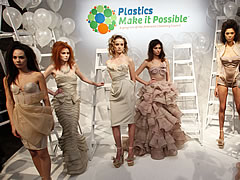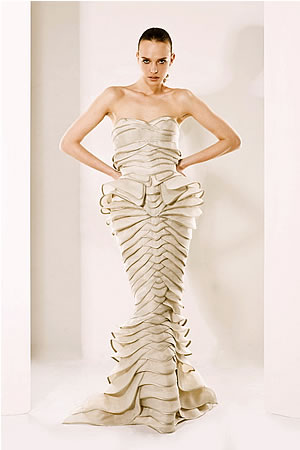Oh the Irony! WesFeld’s Ocean Inspired Plastic Gowns at New York Fashion Week
 Plastic dresses inspired by the ocean? What will those crazy fashion-designing kids think up next?
Plastic dresses inspired by the ocean? What will those crazy fashion-designing kids think up next?
Last week was New York Fashion Week in NY City. I know this because I watch Project Runway, the only reality show I can admit to watching without embarrassment because it’s all about talent and creativity. And in fact, last summer, I got to have lunch with Tim Gunn, who is as nice in person as he appears on the show.
So it was with disappointment I learned that a couple of contestants from the show have been co-opted by the plastics industry. (Thanks, Brande, for sending me the link.) Winners of the 2009 Plastics Make It Possible Design Competition sponsored by the American Chemistry Council (the mouthpiece of the plastics industry), designers Daniel Feld and Wesley Nault created a gorgeous collection of looks called WesFeld, inspired by ocean life. The dresses really are breathtakingly beautiful as well as sadly ironic.


As Wes explains in an interview on the Luxury Fashion blog,
[Our] inspiration is from things that wash up upon shore, like seashells, exoskeletons, starfish, sea glass. We are working with corals, opaque, and neutral colors.
Conspicuously omitted from the list of objects that wash up on shore: plastic trash.
I’ll give the designers the benefit of the doubt. They may not know about the problem of ocean plastic pollution or understand the irony of their designs. But the American Chemistry Council does. In fact, I believe that the ACC is so aware of the irony that it edited out any mention of the ocean or sea that had originally appeared in their article about WesFeld! They may not have counted on the fact that other bloggers had already quoted the original piece.
Check this out. The blog Project RunGay quotes the Plastics Make It Possible Web Site:
Though competition was fierce, WesFeld rose to the top with their use of plastics in creating two looks they titled, “Oceanic Structures.” These wave-like dresses feature materials, such as poly-organza and poly-taffeta, while plastic woven interfacing and plastic boning structure each panel. Even the piping, which gives the dress a satin-like luxury shimmer, is poly. From fiber to fit, these seashell inspired gowns truly are made possible by plastics.”
Now, check out the “original” paragraph on the Plastics Make It Possible web site:
Though competition was fierce, WesFeld rose to the top with their use of plastics in creating the two looks they titled. These wave-like dresses feature materials, such as poly-organza and poly-taffeta, while plastic woven interfacing and plastic boning structure each panel. Even the piping, which gives the dress a satin-like luxury shimmer, is poly. From fiber to fit, these shell inspired gowns truly are made possible by plastics.
The words in purple, “Oceanic Structures” and “sea” are gone entirely from the Plastics Make It Possible site. The first sentence doesn’t even make sense. And yeah, I am the type of person who notices details like this. I’m also the kind of obsessive person who would save a screen shot of the PMIP web site in case they decide to edit that article yet again.
In addition, the Project RunGay site quotes the designers explaining in more detail the oceanic theme of the collection:
The inspiration for this set is inspired by oceanic structures that wash up on shore and slowly bleach out in color by the sun… Emulating the armorial like panels found in nature was not an easy task.. Thankfully after long periods of experimenting we discovered that the plastic woven interfacing and plastic boning would give us the ability to morph our opaque fabrications into something that came to life…
Life from plastic. Plastic imitating nature. I don’t know for sure that the above quote is from the Plastics Make It Possible site, but if it is, it’s not there anymore.
So why would the American Chemistry Council remove references to the ocean from their web site? What is it that they don’t want you to think about?
Plastics Make Ocean Pollution Possible
Plastic pollution is a terrible problem in the world’s oceans. Not only is there a swirling plastic soup in the North Pacific Gyre, discovered 10 years ago by Captain Charles Moore, but a current research team have discovered plastic pollution in the North Atlantic gyre as well. In fact, according to the web site 5 Gyres,
…there are 5 major oceanic gyres worldwide, with several smaller gyres in Alaska and Antarctica. Marine researchers don’t yet know the extent to which plastic pollution exists in the world’s oceans.
Plastic has been found inside the bodies of food fish, making its way up the food chain. And plastics in the ocean attract and accumulate oil-based pollutants like PCBs, so the plastic particles making their way into our food stream are exceptionally toxic.
Plastic litters the word’s beaches, turning them into plastic trash dumps.
Plastic in the ocean harms albatrosses that eat it thinking it’s food and sea turtles that mistake plastic bags for jellyfish. And lest you think that this problem is the fault of consumers and their litter, plastics manufacturers contribute to the problem in a massive way. “Nurdles,” those preproduction plastic pellets from which all plastic products are produced, make their way to the ocean in huge quantities, collecting in and polluting the zooplankton, the very bottom of the food chain.
Perhaps the American Chemistry Council wishes they had awarded their prize to a less ironic design. On the other hand, perhaps they are counting on the public not to notice. The dresses are mesmerizing, aren’t they?








I’m currently a fashion student in the UK and am designing for a marine life theme. Who designed/made these garments above? If someone could help me it would be fantastic! beckywaters@hotmail.com
Plastics make WHAT possible? The ability to kill off thousands of sea birds with trash?
Ugh. And who would want to wear it anyway? Talk about a sweat box!
I’m so glad you care about this. Yesterday I walked the beach (I’m surrounded by them) and it was a plastics day. Meaning, plastic trash was in abundance. So, something happened at sea, and it washed in. Yuck. Ick. Nasty. I should take photos to share with you, I’m sure, when this happens. Keep up the great work!
“Did you know that most plastic recycling is actually ‘downcycling’.
That is the problem in a nutshell Beth. Quality plastic ends up as a toothbrush or in a plastic fibre filled coat that is worn out and discarded.
The only way for plastic to be recycled is down, literally. No matter how often it happens it will end up in the earth.
I just have to say thank you for the inspiration you provide! I am constantly learning and striving to be better. My husband and I have taken up the plastic challenge and can’t wait to see what we find.
Regards,
Jennifer
There is a recent article in Science News about how the garbage gyres are more destructive than first thought, because the debris goes much deeper than the surface, up to 20 km! Here’s the link:
https://www.sciencenews.org/article/sea-plastics
Beth, I continue to greatly admire what you are doing, and I am sadly frustrated at my own attempts, most of which have to do with food storage. But we continue to try our best!
Wow, I’m really amazed about this. I’m taking an Environment Science class in High School and we are learning about how plastics and other trash is polluting the oceans. Just yesterday we were reading up on an article about the North Pacific Gyre and the other ones as well and it was talking about the island’s of trash that, mostly plastic, was creating. I’m a big nature freak when it comes to pollution and other serious problems as well as the problem with cutting down trees, so I understand how most of you are freaking out about this. One of the ways you can help is to just recycle. And from what my teacher in my class told me, Refuse, Reuse, and Recycle. For example, when you go to the grocery store, bring your own bag to help stop throwing away plastic and paper bags. Another way to help, talk to your local recycling community and find out all the things you can recycle like plastic, glass, aluminum and other metals… even paper like cardboard boxes from cake mixes! Trust me, I do this and it saves me a lot of time and money. Like I always say, Save the World, get off your lazy butt and do something. 🙂
Hi Shanell. I am so glad you are learning about these issues. Just remember that Recycling is the very last of the R’s. It’s the one that we resort to when all else fails. It is not our first solution to this problem.
Did you know that most of our plastic recycling is shipped to China, where is may actually be incinerated or manufactured into cheap plastic stuff that is shipped back to us? Did you know that most plastic recycling is actually “downcycling,” which means that plastic items cannot be recycled back into the same plastic items? Take a yogurt container, for example. It will not get recycled into another yogurt container. So that means that new plastic must be used to create new yogurt containers. Not so great.
Reducing the amount of plastic we buy in the first place is the best solution, right?
Check out this list of ideas for cutting out plastic: http://myplasticfreelife.com/plasticfreeguide/
Also, check out the web site of the Plastic Pollution Coalition. They are working hard to stop this problem at a very high level: http://www.plasticpollutioncoalition.org/
Thanks for stopping by! I hope you will continue to care about the planet and what we can do to protect it.
This sort of thing is so off-putting. Corporate spin-masters working overtime to hide the problems with their products are verging on unethical behaviour, and it makes me sad. You shouldn’t need to re-word websites so that people won’t think of the connection between your product and environmental devastation. 🙁
Hi, Tracey. Do you have a link for the Tibetan products you mention? Using old or secondhand animal products is a little controversial in the vegan community, but works for many. I can definitely see both sides.
Back to that trash fashion again, except I use only used materials and we try to make a statement in our shows against plastic. Too bad these designers couldn’t see the irony and make a humorous statement about ocean trash while creating fashion. I try to. Have a show coming up March 27 on Big Island of hawaii and can’t think of anything else these days. Am going to be interviewed by a local newspaper in a few minutes. This month’s ocean cleanup at South Point was cancelled for lack of trash. But could be just ocean currents, tho it’s nice to think we could be making a dent.
I have been primarily vegan for 30+ years.
My answer to the vegan dilemma is to buy nothing new.
Buy second hand leather footwear and warm clothes.
Buy wool.
My favourite fashions are those cotton and recycled fabric marvels by Tibetans in exile.
Hi, Akiko (and Beth!). I am also a vegan and have come to plastic awareness after coming to animal awareness, meaning I have a lot of synthetic stuff that I’m not totally thrilled with at this point. I used to have an awesome winter coat that was Swedish military surplus. It was all cotton and unbelievably warm. I gave it a away when I moved to Florida and miss it a little. Shoes and handbags are a real challenge. And vegan wine with a real cork!
I love this blog because it helps me figure out things I can do differently, more compassionately. Because, after all, we are vegans out of compassion, and there’s nothing compassionate about filling ocean creatures’ homes and stomachs with our human garbage. It’s a challenge to live vegan and low-plastic, but if it were my home, my stomach, my skin, flesh, fur, &c., on the line, I know I’d want somebody else to make the effort on my account. So I make the (imperfect) effort. It’s comforting and encouraging to know others are doing the same.
I hear you, Akiko. It is a dilemma. But I’m quite sure there was nothing about this show encouraging recycled materials. The designers did quite a few Youtube videos about developing their looks, and they never mentioned anything recycled.
I’m listening to the book Eating Animals right now, which is pretty tough to get through. Just heard the part about a turkey farmer who has severe criticism for the way all other turkeys are raised. He says, “If you can’t do turkey right, you shouldn’t raise turkeys.” And “If you are not willing to pay more for a turkey raised right, you shouldn’t eat turkey.”
I guess I feel that if you can’t figure out a way to create gowns without creating harm in the process, maybe you shouldn’t create gowns. One way to avoid the nurdle situation would be to repurpose used fabric rather than making it from recycled plastic, which means nurdles.
Here is my dilemma. Because I help marine animal rescue, I am totally againt unnecessary plastic use. However, because, I love animals and very Vegan, I don’t buy fur, feather, leather, wool, silk, or any kinds of animal products. So, when I need serious warm clothes or comforter, I have to go with sythetic materials. (Do you know how hard to find a cotton fill heavey duty jacket or comforter at a reasonable price?)
There are companies like Patagonia that use recycled polyester or nylon. However, they still have to start from the “nurdles”, which for some reason, always tend to be dropped on the road or in the ocean during transportation.
I have a dance team that performs with plastic trash costumes. It’s for to provoke people and raise public awareness on plastic trash in the ocean. We collect “used plastic trash” to make our costumes.
If the concept of t his fashion show was to encourage manifacturers to use “recycled plastic” to make “trends”, which reduce cost and save animals, I would have to agree with this fashion movement.
To reduce the incidents of nurdles getting into the ocean is another level of action.
I’m not sure what fairy tale I was living in, but I always felt slightly sorry for West Coasters (once I dug beneath the fresh produce and gardening envy) due to their Garbage Patch. Ignorance may be bliss, but understanding is a better motivator. Now that I know they’re in all the oceans, I’ve got even more reason to do the right things.
Those dresses, like most incredibly beautiful decorative objects, have some scary truths behind them.